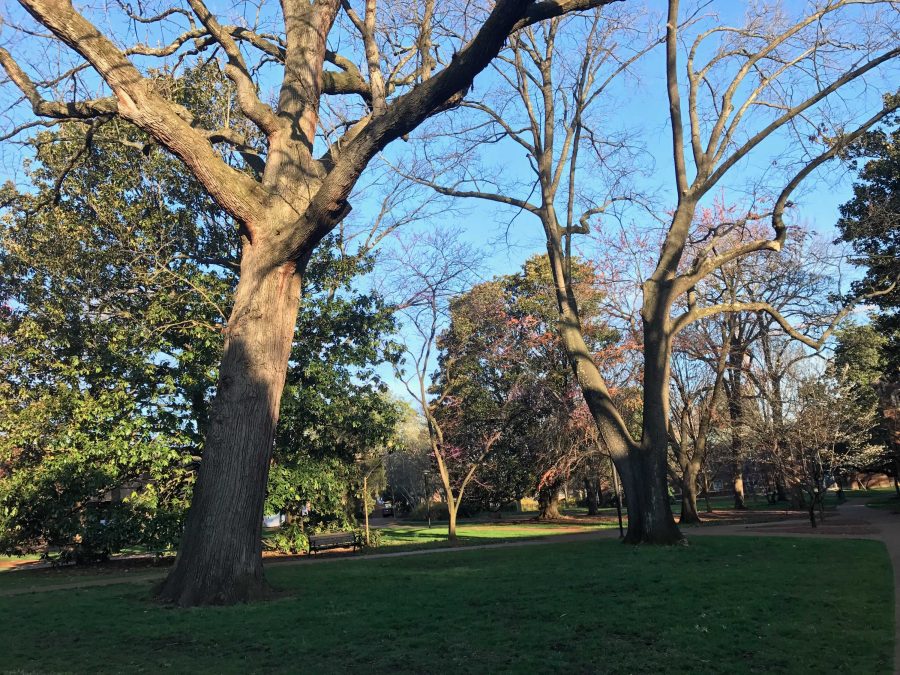On almost any Vanderbilt tour, one will hear about Vanderbilt’s arboretum status and the variety of trees that beautify campus. This arboretum plug has become a selling point for prospective students and their families. Robert Waits, Landscape Architect of Vanderbilt’s Campus Planning and Construction Department, and Steve Baskauf, senior biological sciences lecturer, are both invested in Vanderbilt’s arboretum status and understand what such a title actually entails.
“It’s not like there’s this universal definition of what an arboretum is, really anybody who has some trees can tell people they’re an arboretum,” Baskauf said. “Vanderbilt has been doing this literally since the 1870s.”
Vanderbilt first declared arboreta status in 1878 as part of an educational mission to beautify campus. Since that year, the school has maintained its arboreta status under that same certificate. Every tree on Vanderbilt’s campus makes up the arboretum. Officially, there are different kinds of arboreta statuses that organizations and campuses might obtain. In 1988, Vanderbilt became certified through the American Association of Botanical Gardens and Arboreta (AABGA), which is now known as the American Public Garden Association (APGA).
Beyond the American Public Gardens Association, other organizations certify arboreta and provide classification levels for status. Notably, the Morton Register for Arboreta categorizes arboreta into four levels, the fourth level being an official research arboretum. While Vanderbilt is not officially accredited through this register, Baskauf and Waits both estimate that Vanderbilt is a level II arboretum, meaning Vanderbilt has over 100 species of trees that are labeled and a part of different educational programs. Baskauf currently leads such programs on campus, conducting tree tours periodically throughout the year. Vanderbilt is currently applying for official level II arboretum certification through the Morton Register for Arboreta, or ArbNet. In order to progress to level IV, campus initiatives would have to include official research labs working on Vanderbilt’s trees and using the arboretum as an academic resource.
Today, Vanderbilt’s office of Campus Planning and Construction is involved in almost everything that impacts campus grounds, including the trees. Waits plans tree-planting initiatives that bring 150 to 200 new trees to campus every year. He is working closely with students and administration on the FutureVU Land Use Plan in order to expand Vanderbilt’s campus landscape. Waits says that the office plans on pursuing student initiatives to bring more native plants onto campus.
With regard to Vanderbilt’s arboreta status, Waits believes that the Vanderbilt campus has the capacity to grow. Harvard’s level four certified arboretum, for example, serves as a separate official research lab for students.
“We aren’t a research university when it comes to trees, so that’s kind of where the line gets split when it comes to other universities like Harvard… We do bring in a variety of trees and shrubs that work in our zone and display those to the students. We’d have to get some research backing in order to get to the next levels, and that’s kind of academically driven. That’s not something we drive, but I’d love to see it.”
Harvard’s level four certified arboretum serves as a separate official research lab for students.
Two endowments currently fund portions of Vanderbilt’s arboretum. The Mafis Smith Tree Endowment is used to bring new trees to campus, and the Tree Labeling Endowment contributes to the tree labels seen on many trees around campus. Aside from new plantings and labelings, a grounds crew maintains all of the landscaped areas on campus. Each individual within the crew covers fourteen acres of land.
“Vanderbilt has awesome trees on campus because, for 140 years, people have made the effort to plant and maintain them,” Baskauf said.
Waits has plans to further this maintenance and expand Vanderbilt’s tree landscape. Waits is hoping to extend the aesthetic of old campus’s landscape architecture to areas like West Side Row, the Medical Center and Highland Quad in order to create a more consistent outdoor appearance on campus.

